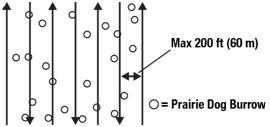Carcass Search & Recovery Guidelines for Black Tailed Prairie Dogs
The availability of dead or intoxicated prairie dogs above ground will be monitored, recorded and these carcasses will be properly disposed of, in accordance with the following:
- The entire treated area must be searched, using the line transect method. Start by dividing the treated area into line-transects (i.e., straight, parallel lines), and using landmarks, stakes or flags to define the width and ends of the transects on opposite ends of the treated area. Flags, stakes, GPS tools or other means should be used as needed within and over the length of the treated area to ensure a thorough inspection, and allow the observer to easily identify the line and return to it after moving off to collect carcasses or excess bait. In all cases, even on flat, unobstructed rangeland or non-crop areas, the distance between transects must not exceed 200 feet (60 meters), to ensure clear visibility, and not missing any portion of the treated area. Treated areas with heavier vegetation need to use closer transect separations to ensure clear visibility, and not missing any portion of the treated area.

- Evaluate the colony for carcass visibility. This may be done by placing a glove or other small brown item on the surface of the treatment area to represent an animal carcass and then measuring the distance at which it is not easily seen. Repeat several times in representative habitat(s). Double the minimum visibility distance to determine appropriate spacing between transect lines.
- Transects should be set at a distance which will allow for unobstructed view, which may mean using natural breaks and creating a new transect at fencelines, hedge rows, ditches, washouts or arroyos, and/or hill crests, as needed in more densely-vegetated areas.
- Consider time of day and position of sun when establishing transect layout to maximize visibility (i.e. looking into the sun at sunrise/sunset decreases visibility).
- Evaluate the colony for carcass visibility. This may be done by placing a glove or other small brown item on the surface of the treatment area to represent an animal carcass and then measuring the distance at which it is not easily seen. Repeat several times in representative habitat(s). Double the minimum visibility distance to determine appropriate spacing between transect lines.
- Carcass search is to be conducted starting within 4 days of bait application and returning at 1- to 2-day intervals, to collect and dispose of any bait or dead or dying black-tailed prairie dogs found on the surface. However, a greater frequency of searches will help to minimize risks of secondary poisoning to predators and scavengers.
- Carcass search may be conducted by walking the line transects of the search area, or by driving a vehicle:
- Travel at a slow speed, not to exceed 4 mph, observing only the area to the left side of the line of travel.
- Then turn around, proceeding back over the same line again, observing the left (opposite) side of the line of travel.
- When a dead/impaired animal or bait is detected, move off the line to address the object and return to the line at the point it was left, then continue to traverse the line and visually scan as before.
- Collect and dispose of dead or dying prairie dogs and search for non-target animals for at least two weeks, but longer if carcasses are still being found at that time.
- Although not specifically required by the label, a longer duration of searches (e.g., until at least five consecutive days of transect efforts with no observances of above ground animals or bait) would help to minimize risks of secondary poisoning to predators and scavengers, given the variability in scavenger removal.
- All dead or dying non-target animals must be reported to the National Pesticide Information Center: 1-800-858-7378 as soon as possible.
- Any apparently injured or sick federally listed species must also be immediately reported by calling 303-236-7540 (if located in Kansas, Nebraska, the Dakotas, Montana, Colorado or Wyoming) or 505-248-7889 (if located in Texas, New Mexico or Oklahoma).
- Check https://www.fws.gov/endangered/ to determine if a species is federally listed.
- The Black-footed Ferret Coordinator must also be contacted if ferrets are found during Rozol Prairie Dog Bait applications or carcass searches at 970-897-2730 x224.
- All carcasses must be properly disposed of to make them unavailable to predators/scavengers.
- Carcass collection must occur at 1-2 day intervals and collection should occur in late afternoon, near sundown to reduce the potential of nocturnal animals finding carcasses and dying animals.
- Although not specifically required on the label, more frequent carcass collections (e.g., twice a day) will reduce potential for exposure to all predators and specifically, searches in the morning will reduce exposure to daytime sight predators such as hawks and eagles.
- Carcasses must be properly disposed of to minimize risks of secondary poisoning to predators and scavengers.
- Carcasses can be buried on site in holes dug at least 18 inches deep or in inactive burrows (no longer being used by prairie dogs or other species) to avoid non-target animal scavenging.
- Burial includes covering and packing the hole or burrow with soil.
- If burial is not practical (due to frozen ground, etc.) and other disposal methods are allowed by state and local authorities, collected carcasses may be disposed of by state-approved methods that ensure the carcasses are inaccessible to scavengers.
- Although not specifically stated on the label, the most effective method for disposing of carcasses and minimizing risks of secondary poisoning to predators and scavengers is to dispose of the collected carcasses by state-approved methods that ensure the carcasses are inaccessible.
